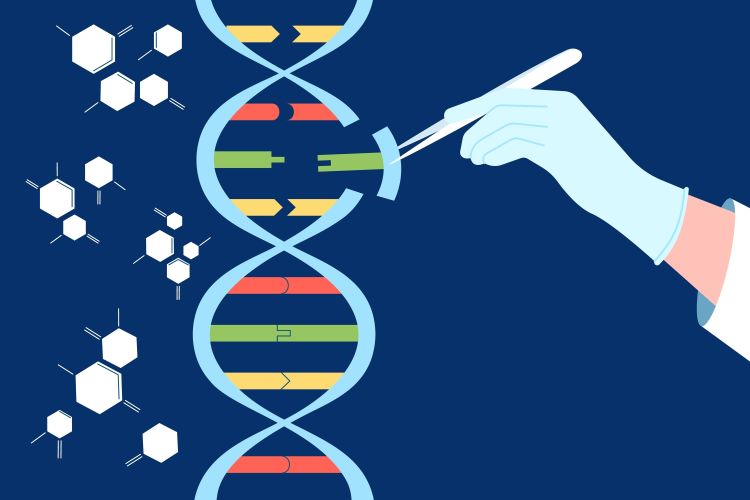Revolutionizing Gene Therapy: CRISPR's Whole Gene Insertion Capability

Table of Contents
CRISPR-Cas Systems: Beyond Gene Editing
CRISPR-Cas systems are revolutionary gene-editing tools derived from a bacterial defense mechanism. Initially, their applications focused on gene knockout—disrupting a gene's function—and correcting point mutations—single-base changes in DNA. These techniques proved highly successful in treating certain genetic disorders. However, traditional CRISPR approaches faced limitations when it came to inserting large DNA sequences, such as entire genes. This is where the concept of whole gene insertion using CRISPR emerges as a significant advancement.
- Traditional CRISPR limitations:
- Difficulty inserting large genes due to the low efficiency of homology-directed repair (HDR).
- Potential for off-target effects—unintended edits at other locations in the genome.
- Advantages of whole gene insertion:
- Restoring complete gene function, addressing complex genetic disorders that require the entire gene to be functional.
- Potentially treating a wider range of diseases compared to traditional gene editing methods.
- Different CRISPR-Cas systems and their suitability for whole gene insertion: While Cas9 is widely used, other systems like Cas12 are being explored for their potential advantages in precise large-scale insertions. The choice of system often depends on the specific target and desired outcome.
Techniques for CRISPR-Mediated Whole Gene Insertion
Several techniques are being developed to improve the efficiency and accuracy of CRISPR-mediated whole gene insertion:
Homology-Directed Repair (HDR) Enhancement
HDR is a cellular mechanism that uses a provided DNA template to accurately repair double-strand breaks in DNA. This mechanism is crucial for precise gene insertion. However, HDR is naturally less efficient than other repair pathways like non-homologous end joining (NHEJ).
- Optimizing donor DNA templates: Careful design of the donor DNA template, including homology arms flanking the gene to be inserted, is critical for efficient integration.
- Utilizing HDR-enhancing molecules: Researchers are exploring various molecules and strategies to increase HDR rates, such as inhibiting NHEJ pathways.
- Addressing challenges associated with low HDR efficiency: This remains a major hurdle, and researchers are actively working on improving HDR efficiency to achieve higher rates of successful whole gene insertion.
Non-Homologous End Joining (NHEJ) Modulation
NHEJ is another DNA repair pathway that joins broken DNA ends without using a template. While less precise than HDR, NHEJ can be utilized for large gene insertions, albeit with a higher risk of off-target effects.
- Utilizing NHEJ inhibitors: Inhibiting NHEJ can improve the relative efficiency of HDR, thus increasing the chances of accurate whole gene insertion.
- Exploring alternative strategies to reduce off-target integration events: Researchers are developing sophisticated strategies to minimize unintended insertions using NHEJ.
- Evaluating the trade-off between efficiency and accuracy: The use of NHEJ for whole gene insertion represents a trade-off between efficiency (higher insertion rates) and accuracy (higher risk of errors).
Prime Editing and other advanced CRISPR techniques
Prime editing, a more recently developed CRISPR technology, allows for precise gene editing without requiring a double-stranded DNA break. This offers potential advantages for large-scale gene insertion with potentially reduced off-target effects compared to traditional CRISPR-Cas9 methods. Other advanced CRISPR systems are also under development and show promising results for precise and efficient gene insertion.
- Advantages and disadvantages of these advanced techniques: These newer techniques offer higher precision and potentially lower off-target rates, but may also have lower efficiency than older methods.
- Potential applications of these techniques for whole gene insertion: These advanced techniques are expected to play a crucial role in future applications of whole gene insertion in gene therapy.
Applications and Potential of CRISPR Whole Gene Insertion in Gene Therapy
CRISPR-mediated whole gene insertion holds immense potential across various therapeutic areas:
Treating Genetic Diseases
Whole gene insertion offers a powerful approach for treating monogenic disorders caused by single gene defects.
- Specific examples: Cystic fibrosis, sickle cell anemia, and hemophilia are prime candidates for treatment through the insertion of functional gene copies.
- Potential applications in personalized medicine: The ability to precisely insert genes makes this approach highly adaptable to individual patients.
- Ethical considerations and challenges: Ensuring the safety and efficacy of the technology and addressing ethical concerns regarding germline editing are crucial.
Cancer Therapy
CRISPR can be used to insert therapeutic genes into immune cells, enhancing their ability to target and destroy cancer cells. This has implications for improved CAR T-cell therapies.
Gene Replacement Therapy
This approach involves replacing a nonfunctional gene with a fully functional copy, effectively correcting the genetic defect.
Challenges and Future Directions in CRISPR Whole Gene Insertion
Despite its immense potential, CRISPR whole gene insertion faces several challenges:
- Off-target effects: Minimizing unintended edits remains a critical concern.
- Delivery challenges: Efficiently delivering CRISPR components and donor DNA to the target cells in vivo is a significant hurdle. Viral vectors are commonly used but have limitations; non-viral delivery methods are being actively developed.
- Immune responses: The body's immune system may recognize and attack CRISPR components or the inserted gene, leading to adverse effects.
Future research will focus on:
- Strategies for minimizing off-target effects: Advanced CRISPR systems, improved guide RNA design, and novel delivery methods will be crucial.
- Development of safer and more efficient gene delivery systems: This includes improving viral vectors and exploring non-viral delivery approaches such as nanoparticles.
- Overcoming immune responses: Strategies to mask or modify CRISPR components to evade immune detection are being actively explored.
Conclusion
CRISPR-Cas systems, particularly their advanced capacity for whole gene insertion, represent a significant advancement in gene therapy. This technology holds immense potential for treating a wide range of genetic disorders and cancers, offering the possibility of correcting underlying genetic defects and restoring normal gene function. While challenges remain in optimizing delivery and minimizing off-target effects, ongoing research is rapidly advancing the field. Further development and refinement of CRISPR-mediated whole gene insertion techniques will pave the way for a new era of effective and personalized gene therapies. Learn more about the exciting advancements in CRISPR whole gene insertion and its potential to transform the future of medicine.

Featured Posts
-
 Upcoming Meeting Portugals President To Consult Parties On Prime Minister Selection
May 30, 2025
Upcoming Meeting Portugals President To Consult Parties On Prime Minister Selection
May 30, 2025 -
 San Diego International Airport Flight Delays What You Need To Know
May 30, 2025
San Diego International Airport Flight Delays What You Need To Know
May 30, 2025 -
 Hadir Dengan Sentuhan Klasik Review Lengkap Kawasaki W800 My 2025
May 30, 2025
Hadir Dengan Sentuhan Klasik Review Lengkap Kawasaki W800 My 2025
May 30, 2025 -
 Coldplay Seoul Concert Jins Promise Of Btss Soon Return
May 30, 2025
Coldplay Seoul Concert Jins Promise Of Btss Soon Return
May 30, 2025 -
 Bad Bunny Entradas Preventa Ticketmaster Y Live Nation Madrid And Barcelona
May 30, 2025
Bad Bunny Entradas Preventa Ticketmaster Y Live Nation Madrid And Barcelona
May 30, 2025
